Global Private Equity Report

Executive Summary
- The 2022 meltdown among crypto companies raised plenty of anxiety about the future of blockchains, smart contracts, and tokens.
- But the real promise of these web3 tools and technologies extends far beyond the volatile and often speculative world of crypto.
- For private equity, web3 will have important implications for how funds invest, underwrite risk, and raise new capital.
This article is part of Bain’s 2023 Global Private Equity Report
Anyone who lived through the dot-com meltdown in the early 2000s will undoubtedly see parallels in the current crypto collapse. Irrational exuberance (check). Lack of investment discipline (check). Implosions begetting implosions (check). Fraud and scammery (check and check).
But these two periods of excess share something else in common that will have a much longer-lived impact on investing. Just as the first generation of Internet technology matured to drive a wave of innovation in how we live and work, the technologies behind crypto—collectively known as web3—will continue to have broad impact beyond the world of Bitcoin and Bored Apes.
Paradigm shift?
Watching almost $3 trillion in web3-related asset value shrink by more than 70% is unnerving, to say the least. But the rise and fall of crypto isn’t really the issue. What counts are the core underlying technologies that have made web3 possible, a set of innovations that will have far-reaching implications for many parts of the global economy, private equity included.
The emerging web3 ecosystem now boasts thousands of companies funded by approximately $94 billion in start-up capital from venture funds, hedge funds, private equity, and other investors (see Figure 1). Major companies across industries—JPMorgan, Goldman Sachs, Google, and Disney among them—have begun to think about how web3 will influence their businesses and what it could unlock in terms of managing transactions and engaging with customers. Crypto and nonfungible tokens (NFTs) have led wealthy young consumers to some of web3’s foundational concepts, like digital wallets that can be used across platforms. Forward-thinking private equity firms are also focused on the ways in which blockchains, tokens, smart contracts, and related web3 technologies will affect how they invest and operate.
Investors have poured approximately $94 billion into web3 companies in recent years, most of it since 2021
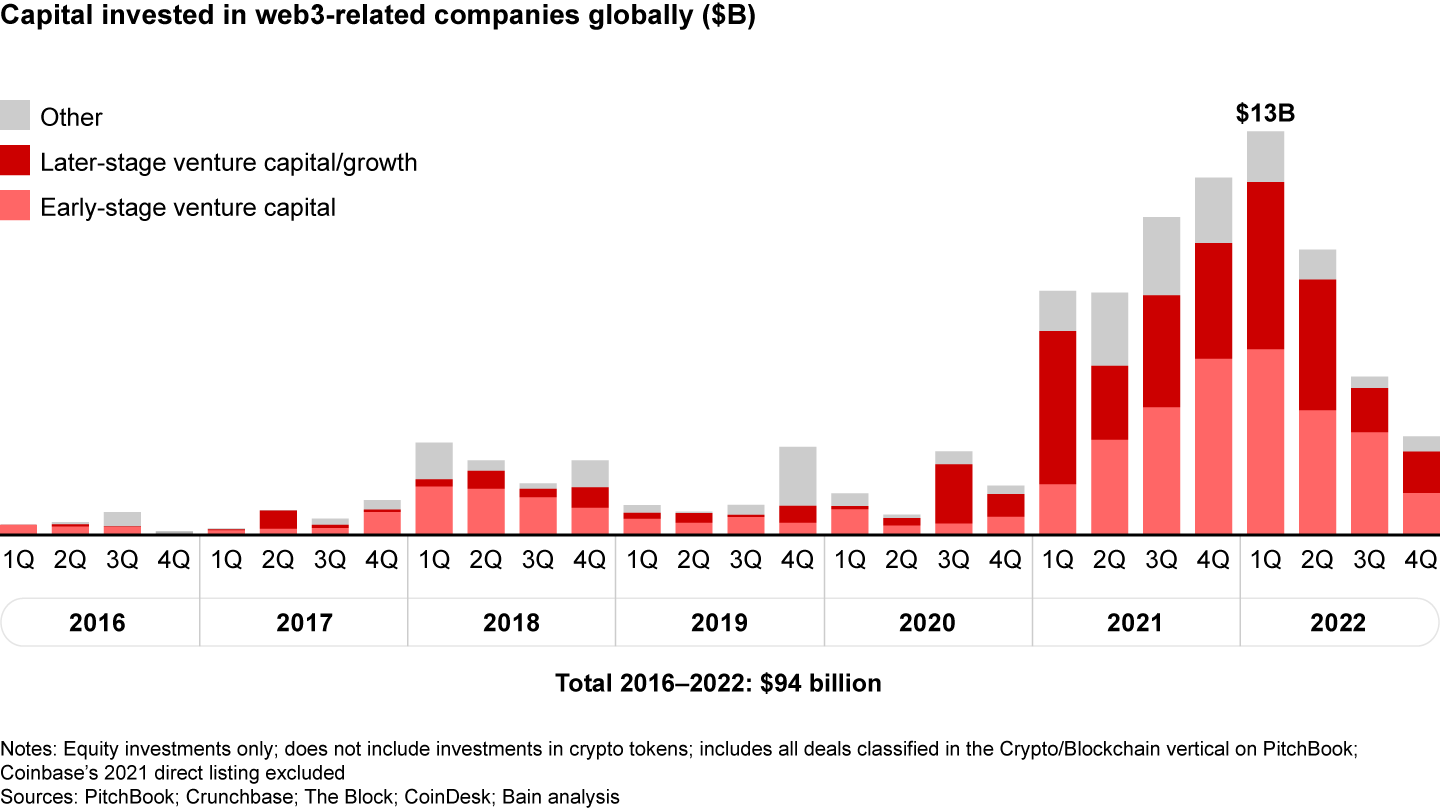
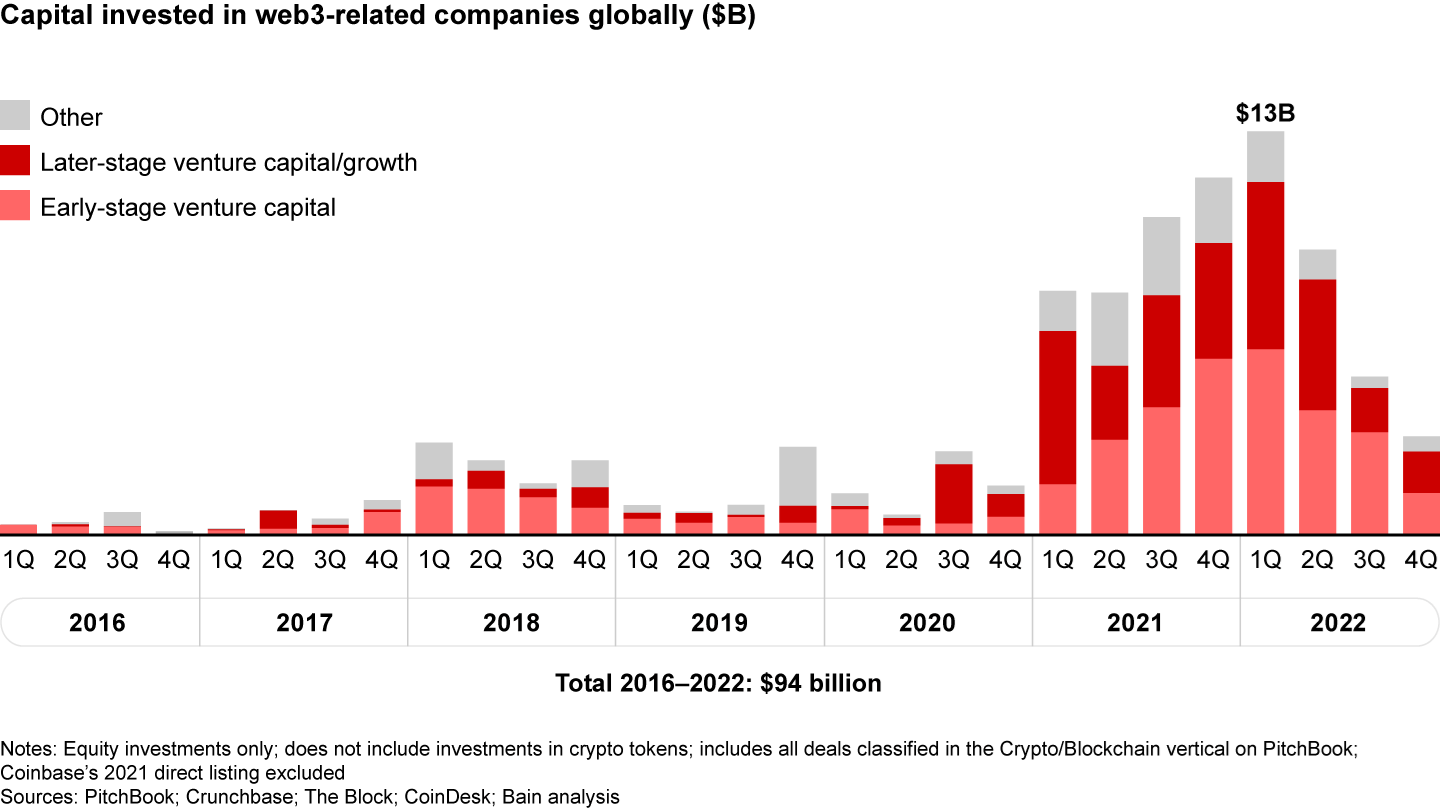
These are still early days, and the recent crypto turmoil highlights how volatile technological innovation and regulatory transitions can be. But in some respects, the market correction and systematic cracks it exposed stand to encourage the sort of rulemaking and business model innovation that can accelerate web3’s evolution. Much as in the early, halting days of e-commerce, the evidence suggests that these innovations are unlikely to fade away.
Already, we see three important ways in which web3 is becoming increasingly relevant for private equity:
- As an investment theme. Web3 will continue to attract sophisticated investors as blockchains and related technologies become part of the underlying infrastructure for a wide range of industries and use cases—not just crypto, which will be a small part of overall web3 development.
- As a disruptive threat (or opportunity) for the portfolio. Even if they aren’t in the game as investors, proactive funds are scanning their portfolios and augmenting due diligence of traditional companies, looking for web3 disruption threats and opportunities to create new value.
- As a tool for new fund strategies. Digital tokens have the potential to transform how private equity funds raise and administer money. They could open up pathways to wealthy individuals and hasten the development of more-liquid fund formats. They could also lower administration costs and make fund operations more efficient.
The web3 investment opportunity
Despite all the Sturm und Drang around crypto, there’s no denying it has been an important proof of concept for how web3 technologies work together. Web3’s promise is an improved version of the Internet, one that is more interoperable than today’s siloed web.
Web1, which launched in the 1990s, was read-only, meaning content was pushed at users and nothing flowed the other way. Web2 ushered in social media and the ability to post your own content. Web3 is evolving as a new kind of Internet, with open protocols and standards that allow for new avenues of value transfer, data sharing, and application development across platforms.
The foundational building blocks are blockchains, smart contracts, and tokens. Blockchains are open, decentralized databases and computing platforms that create security through a consensus mechanism. With the development of Ethereum starting in 2014, blockchains allowed users to securely execute lines of code—known as smart contracts—“on chain.” Tokens, meanwhile, are digital representations of data or assets registered on the blockchain ledger. They can be imbued with clearly defined terms of use (such as trading or governance restrictions) and can carry with them reams of data (escrow information for a real estate asset, say, or gaming assets that can be moved from platform to platform).
From these building blocks come many core web3 concepts and tools. They include dApps (decentralized applications built on blockchain networks), DeFi (decentralized finance networks enabled by smart contracts), DAOs (decentralized autonomous organizations), digital wallets enabling persistent digital identity, and open metaverses (see Figure 2).
Web3 encompasses an array of concepts and tools
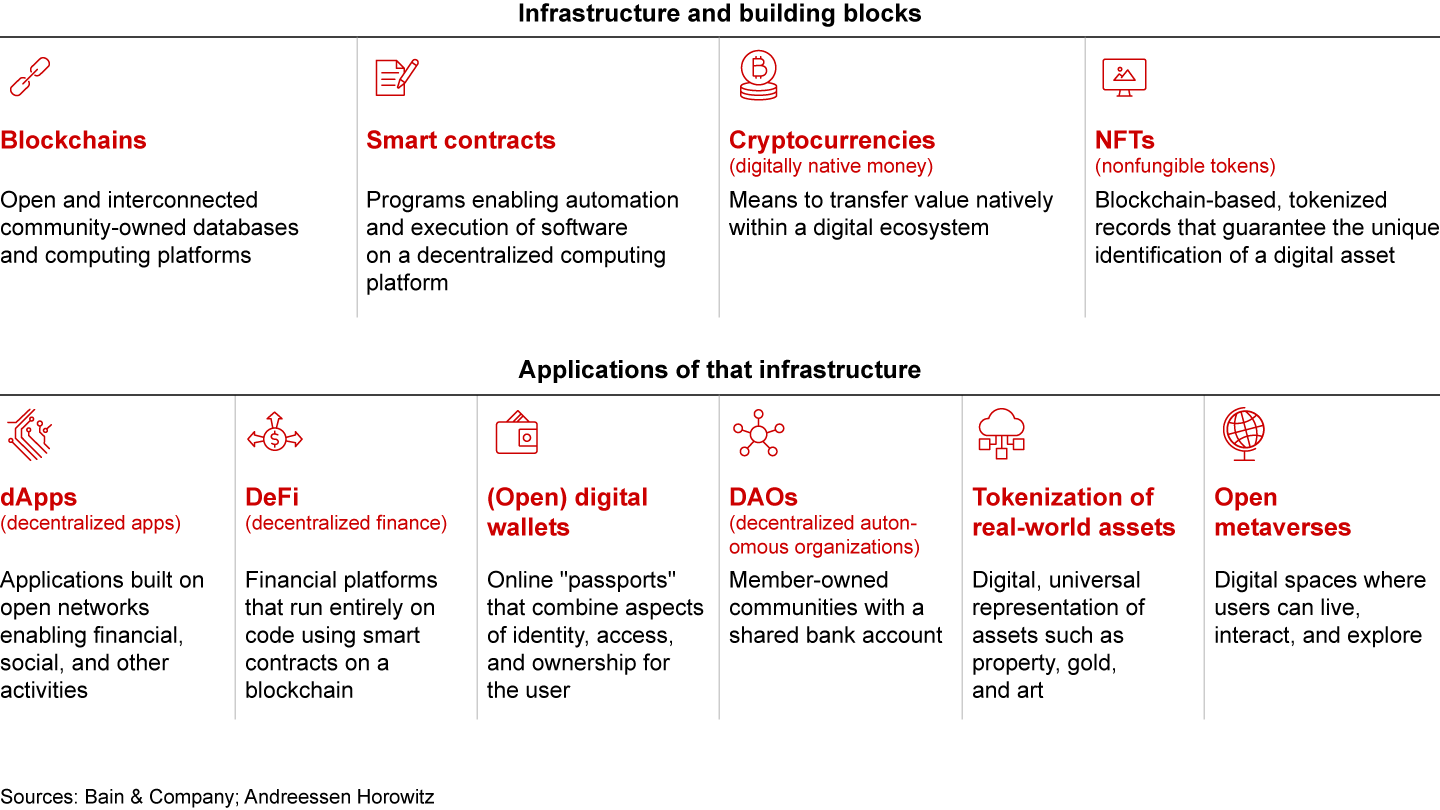
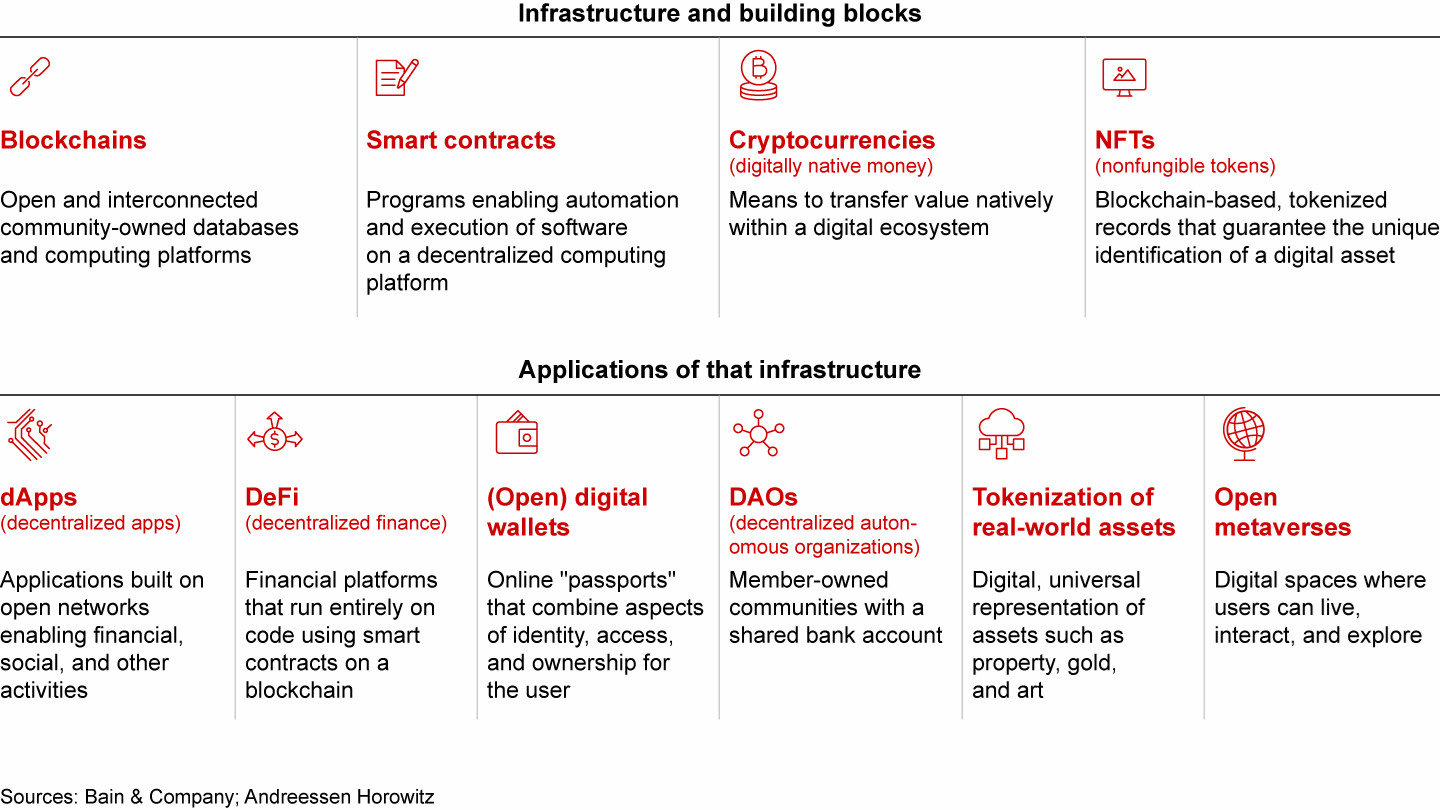
An example of smart contracts, tokens, and decentralized finance in action is the project JPMorgan, DBS Bank, and SBI Digital Asset Holdings implemented in November 2022 for the Monetary Authority of Singapore. It enabled foreign exchange and government bond transactions against liquidity pools comprised of tokenized Singapore Government Securities bonds, Japanese government bonds, Japanese yen, and Singapore dollars. Similarly, Goldman Sachs recently used its tokenization platform to arrange a €100 million bond sale between the European Investment Bank and two others. The sale settled in 60 seconds instead of the usual five days.
Blockchain technology is abstruse. But it has opened minds to basic questions about the way things have always been run. Why, for instance, does it take more than an instant to wire money to London? If bitcoins can be traded around the clock, why not a share of Apple—or a piece of KKR’s latest fund?
While blockchains, smart contracts, and tokens have gained the most traction in the finance sector so far, that’s changing rapidly. Despite some growing pains, IBM’s Supply Chain Intelligence Suite, for example, helps companies use shared ledgers on blockchains to increase supply chain transparency and traceability, while sharing data more securely and efficiently with supply chain partners. In transport, companies including FedEx, UPS, Delta Air Lines, and BNSF take part in the Blockchain in Transport Alliance to develop standards for blockchain-enabled technologies in the transportation and logistics industries.
These efforts aren’t easy. Besides the technical challenges, web3 solutions inevitably require changes to longstanding company and industry practices that can take time to resolve. But what started in Internet forums and white papers has turned into a full-fledged ecosystem over the last decade. Bain & Company’s web3 and digital asset database tracks nearly 5,000 firms that have cumulatively raised more than $94 billion, most of it over the past three years. Investment in 2022 declined from the frenzied pace a year earlier. But even in a less heated market, private investors injected between $20 billion and $30 billion into web3-related companies during the year. And that number doesn’t include the significant internal investments made by corporations and financial institutions.
Initially, the web3 space was the domain of early-stage investors. But dealmaking has broadened to include later-stage growth funds, crossover funds, and even buyout funds. In our experience, the funds wading into this volatile space successfully are establishing a few essential prerequisites:
- They are carefully matching targets to their specific mandate and risk appetite, making sure to create alignment around these choices from the investment committee on down. Firms are accomplishing this matching through their standard investment frameworks, but others are creating special vehicles. One large diversified buyout firm formed a separate fund with a clear mandate to go after Series A and B investments based on highly specific theses focused on web3 infrastructure.
- They are rapidly standing up teams to develop fluency in how web3 is likely to evolve over the next 5 to 10 years and networking across the ecosystem to tap or hire specialized expertise. One firm, for instance, formed a team of four professionals devoted to tracking the web3 space and finding investments. Part of its mandate was to upskill others on the broader team to drive web3 awareness across the firm.
- They are combining depth in web3 with their existing sector expertise to ensure that they understand specific use cases in due diligence and derive the sharpest investment insights subsector by subsector. Funds take two general approaches to this: creating a central web3 SWAT team to work with sector specialists, or embedding web3 specialists in select sector teams to eventually create subsector web3 experts. Either way, the benefit is balance: Web3 expertise is essential to identify the shape of potential disruption, and sector expertise is equally essential to understand specific industry impacts and which profit pools might be affected.
A pragmatic way to make sense of the web3 universe is to separate it into categories. Financial infrastructure companies like crypto exchanges, brokerages, and custodians have attracted by far the most investment to date (see Figure 3). But capital is increasingly flowing to other parts of the ecosystem—the companies developing layer-one and layer-two blockchains, for example, or the core technology at the foundation of this infrastructure. There are also firms building software and developer tools on top of blockchains that enable specific use cases. Finally, there are user-facing applications and systems like gaming apps or NFT markets.
Figure 3: Figure 3
Financial market infrastructure companies have received more than half of all web3 investment to date, but the market is broadening
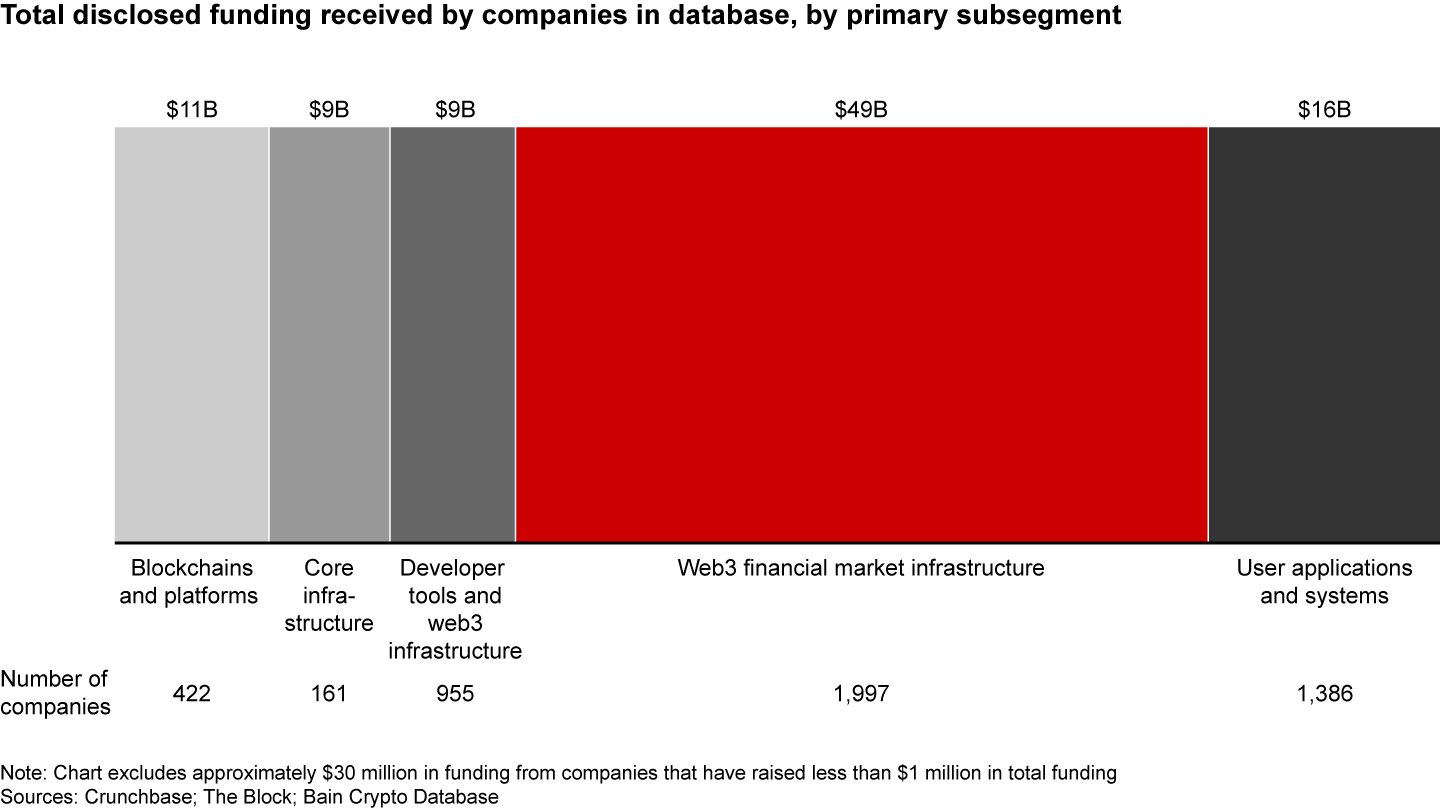
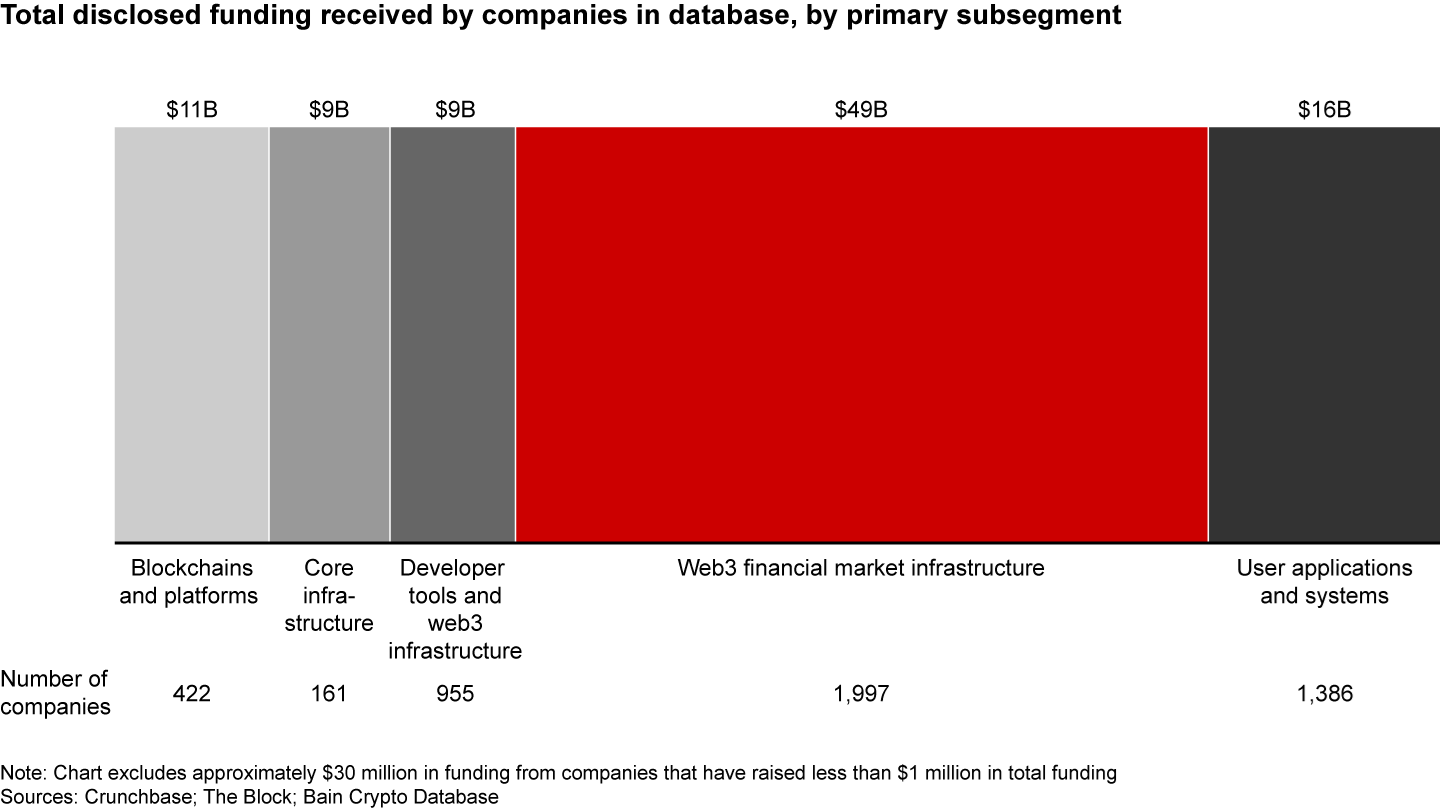
Figure 3: Figure 3
Blockchains and platforms have attracted about $11 billion of web3 company funding
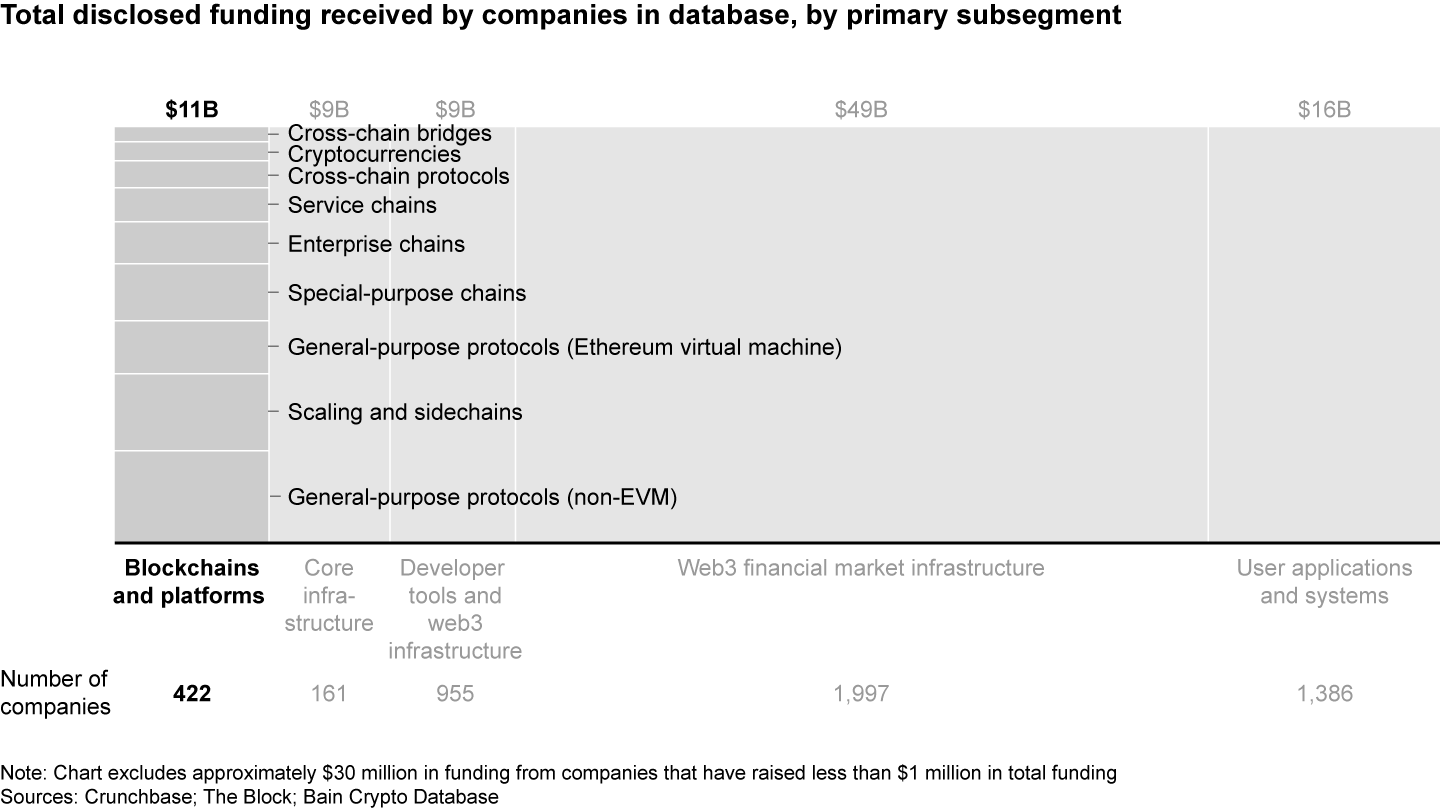
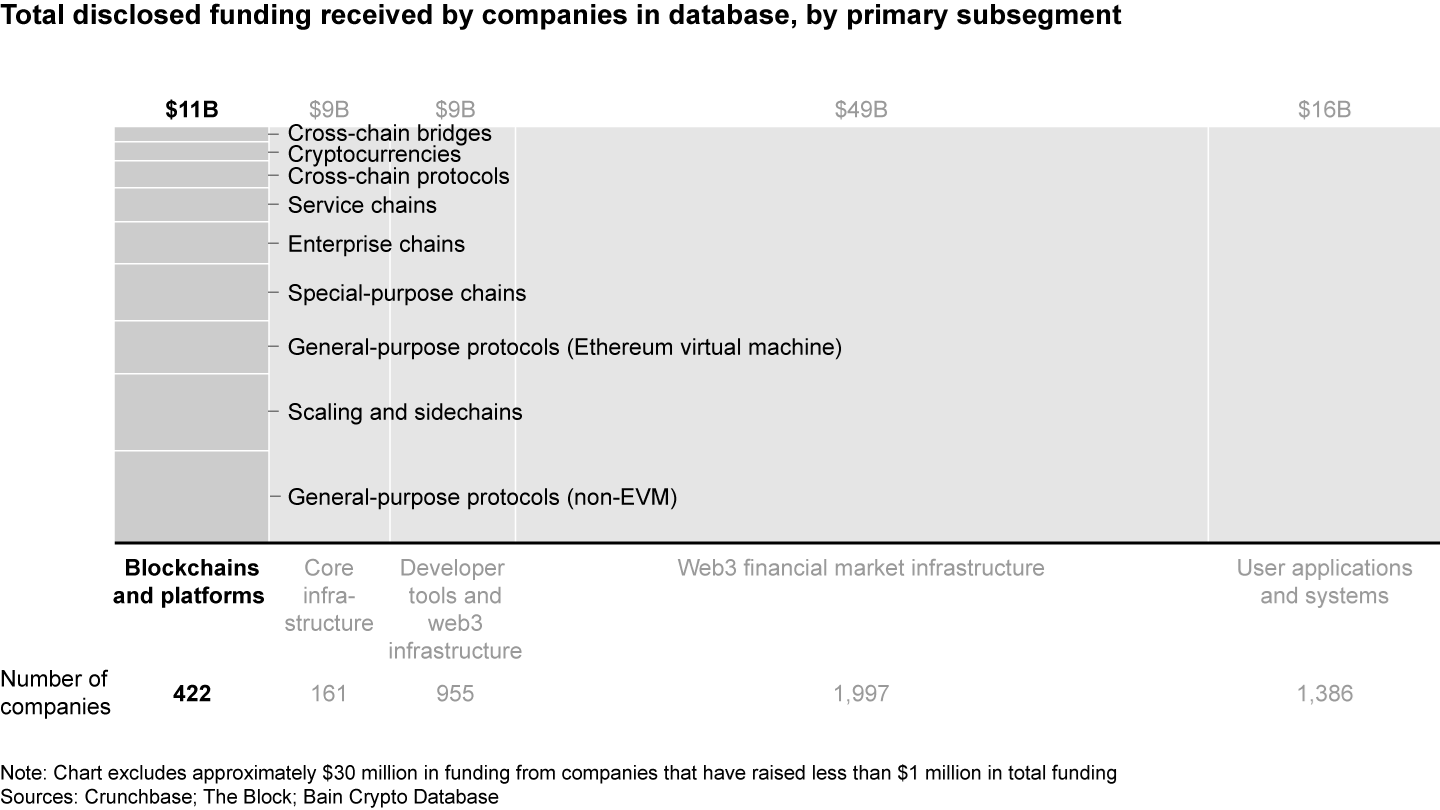
Figure 3: Figure 3
Core infrastructure has attracted about $9 billion of web3 company funding
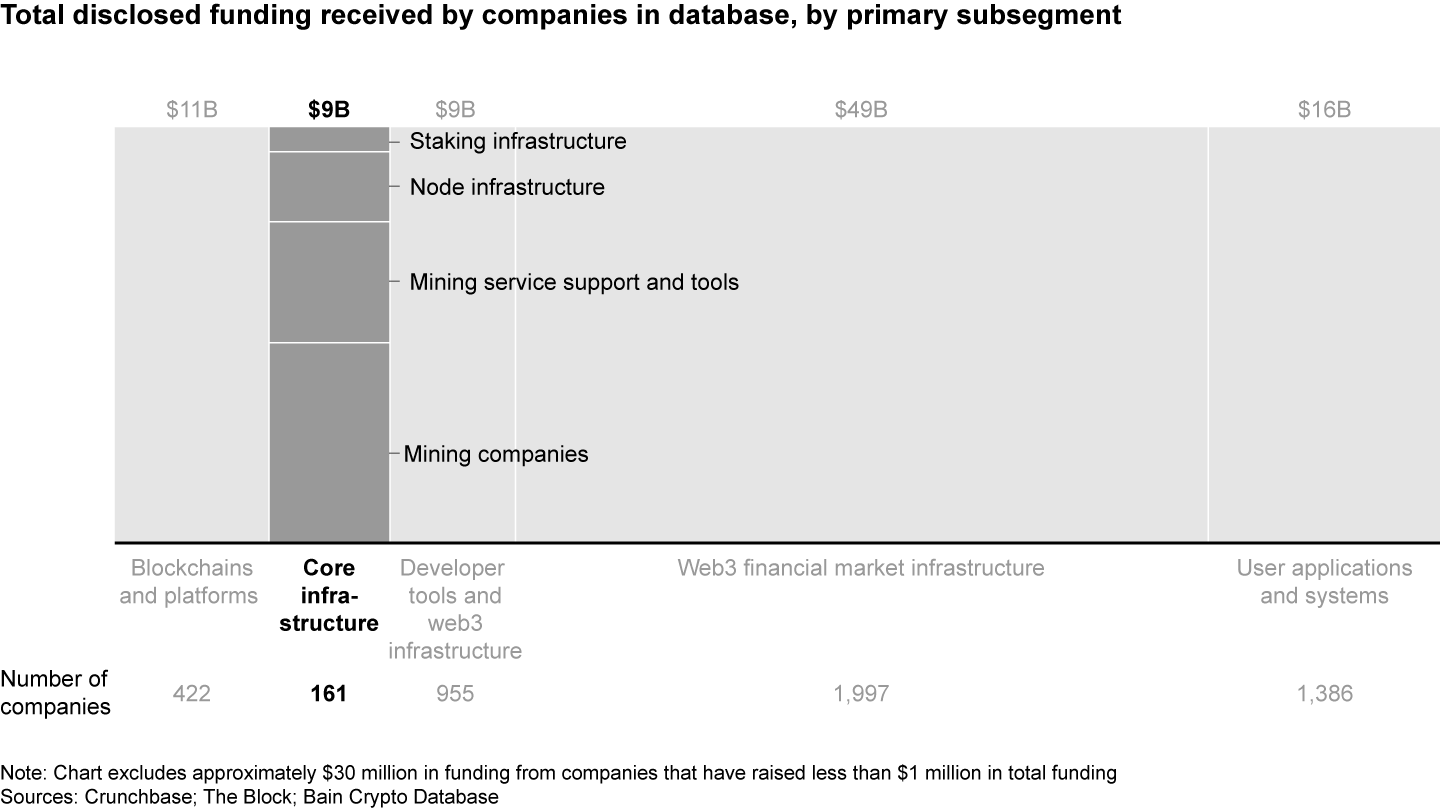
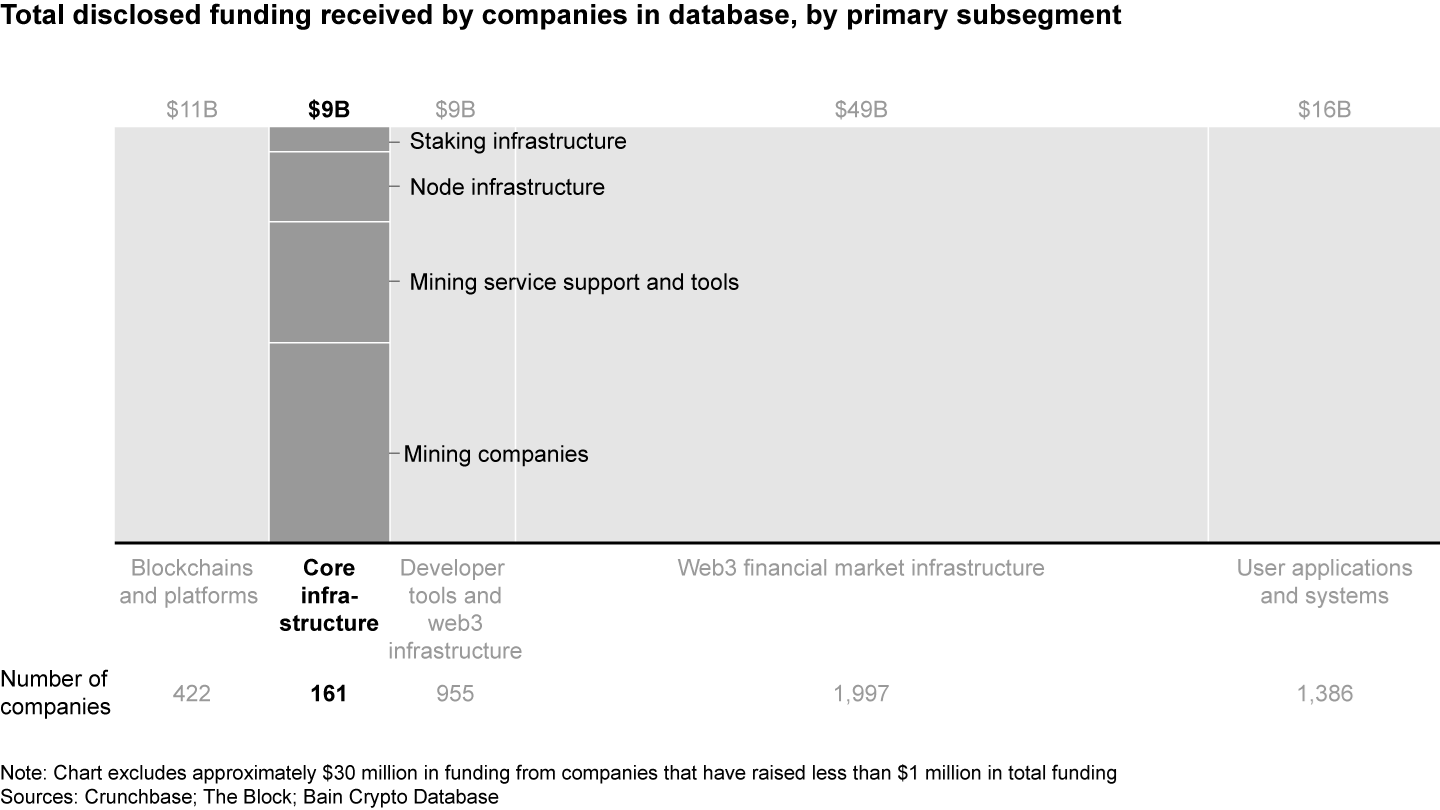
Figure 3: Figure 3
Developer tools and web3 infrastructure have attracted about $9 billion of web3 company funding
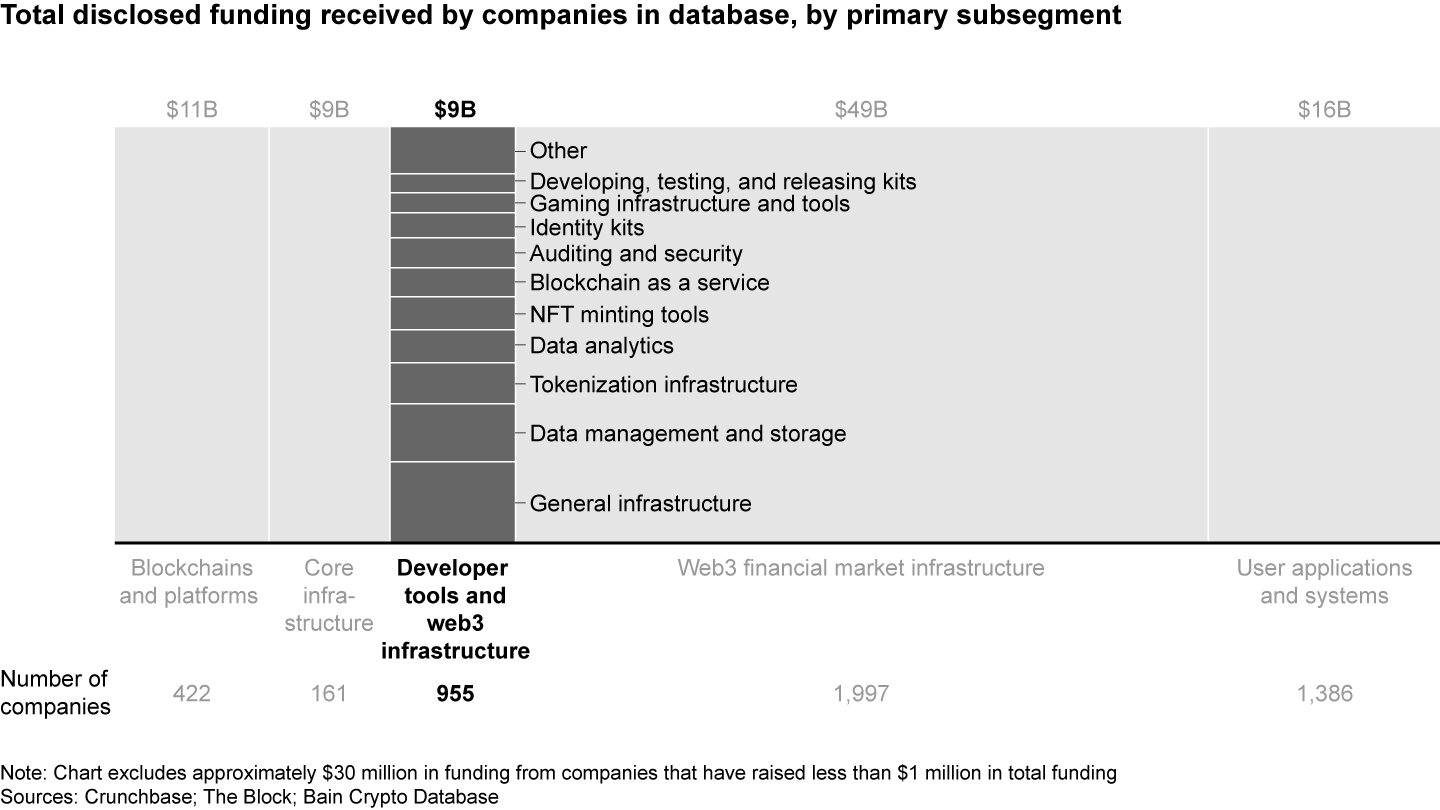
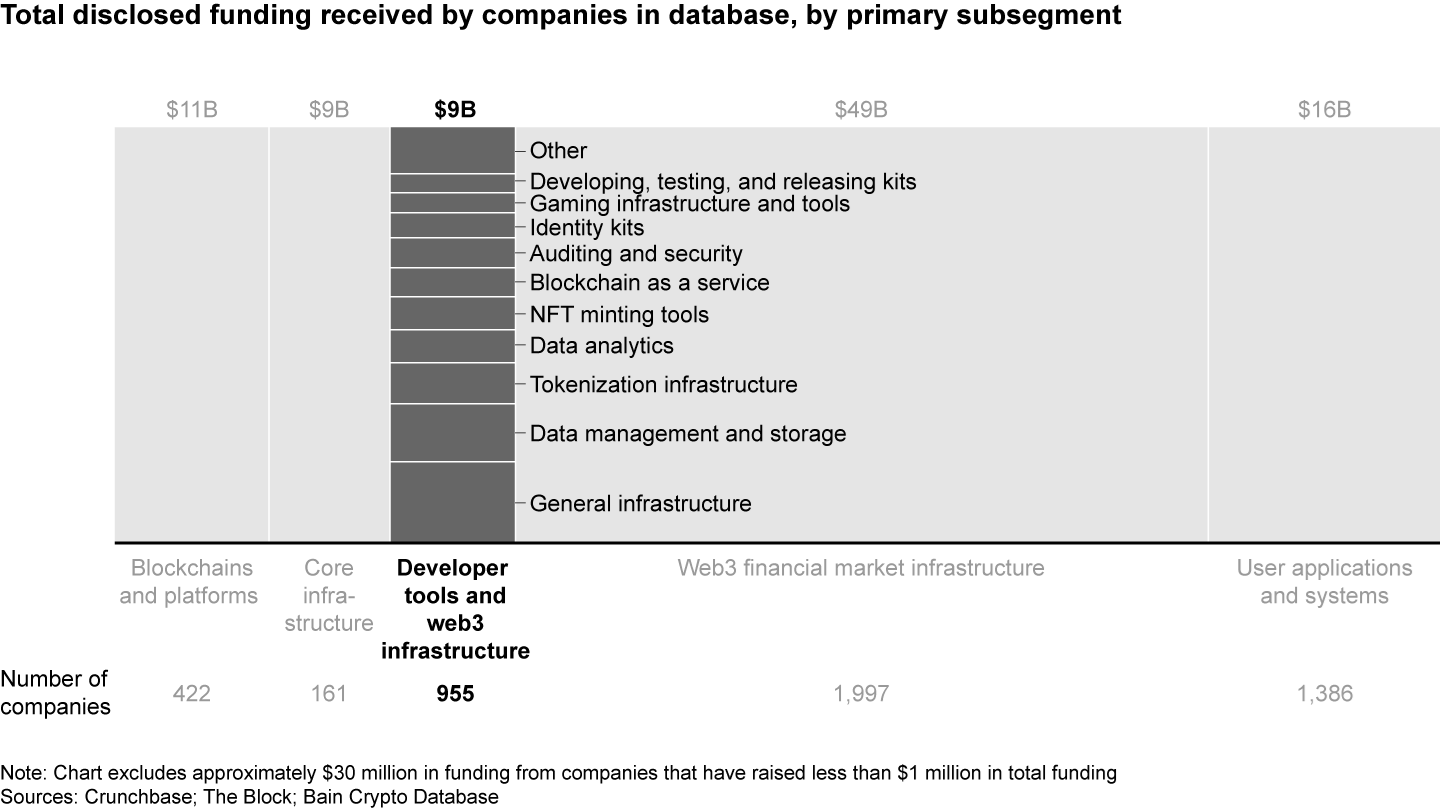
Figure 3: Figure 3
Financial market infrastructure companies have received about $49 billion of web3 company funding
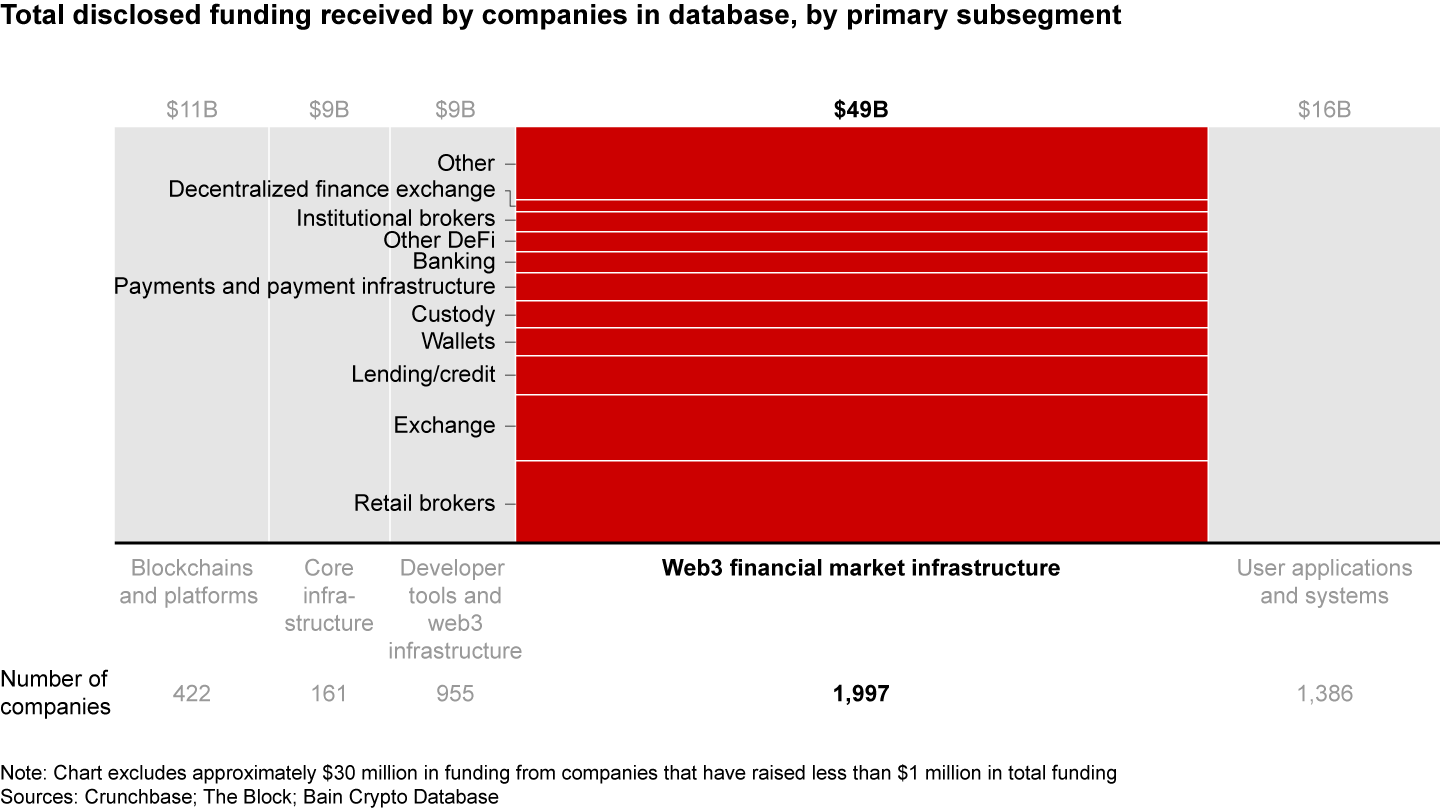
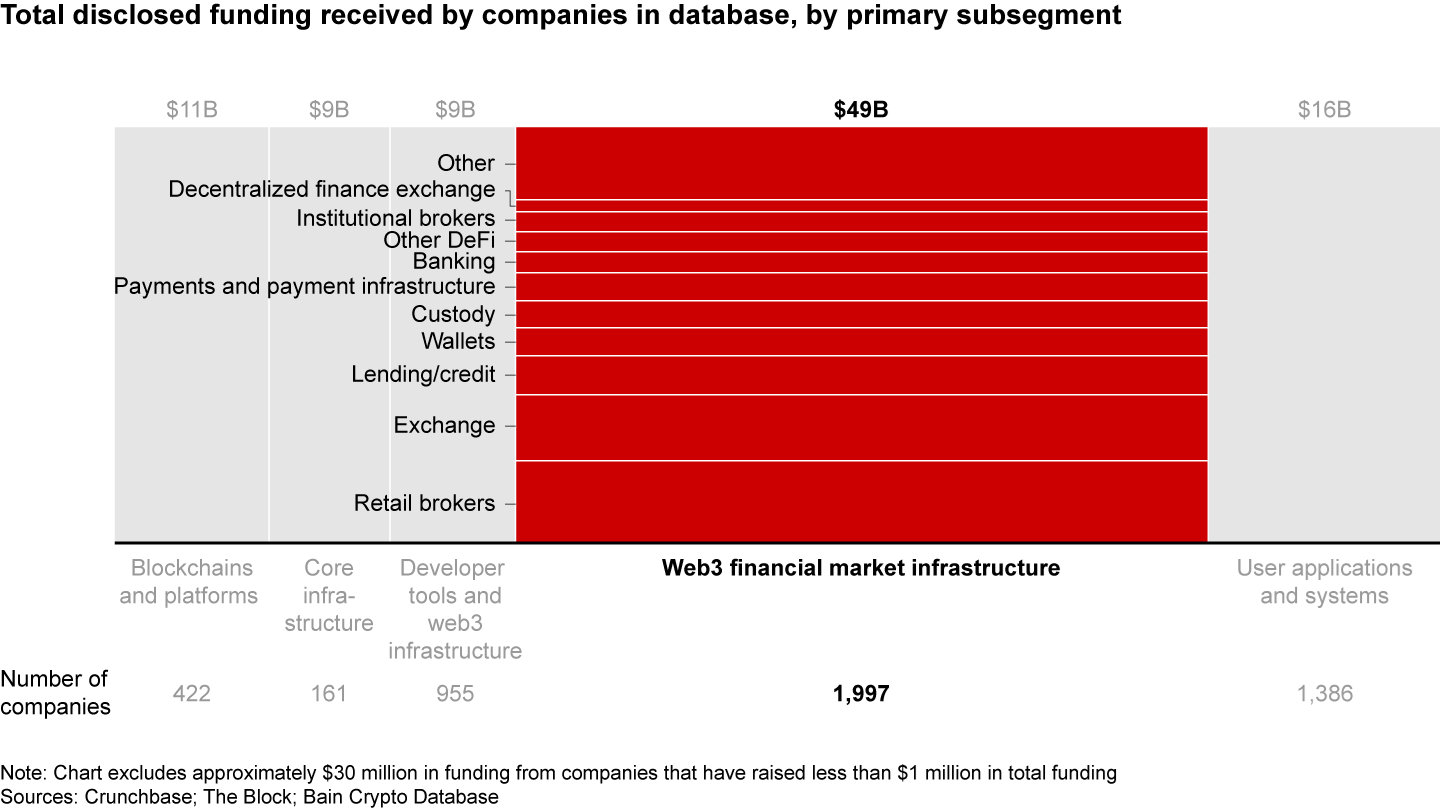
Figure 3: Figure 3
User applications and systems have attracted about $16 billion of web3 company funding
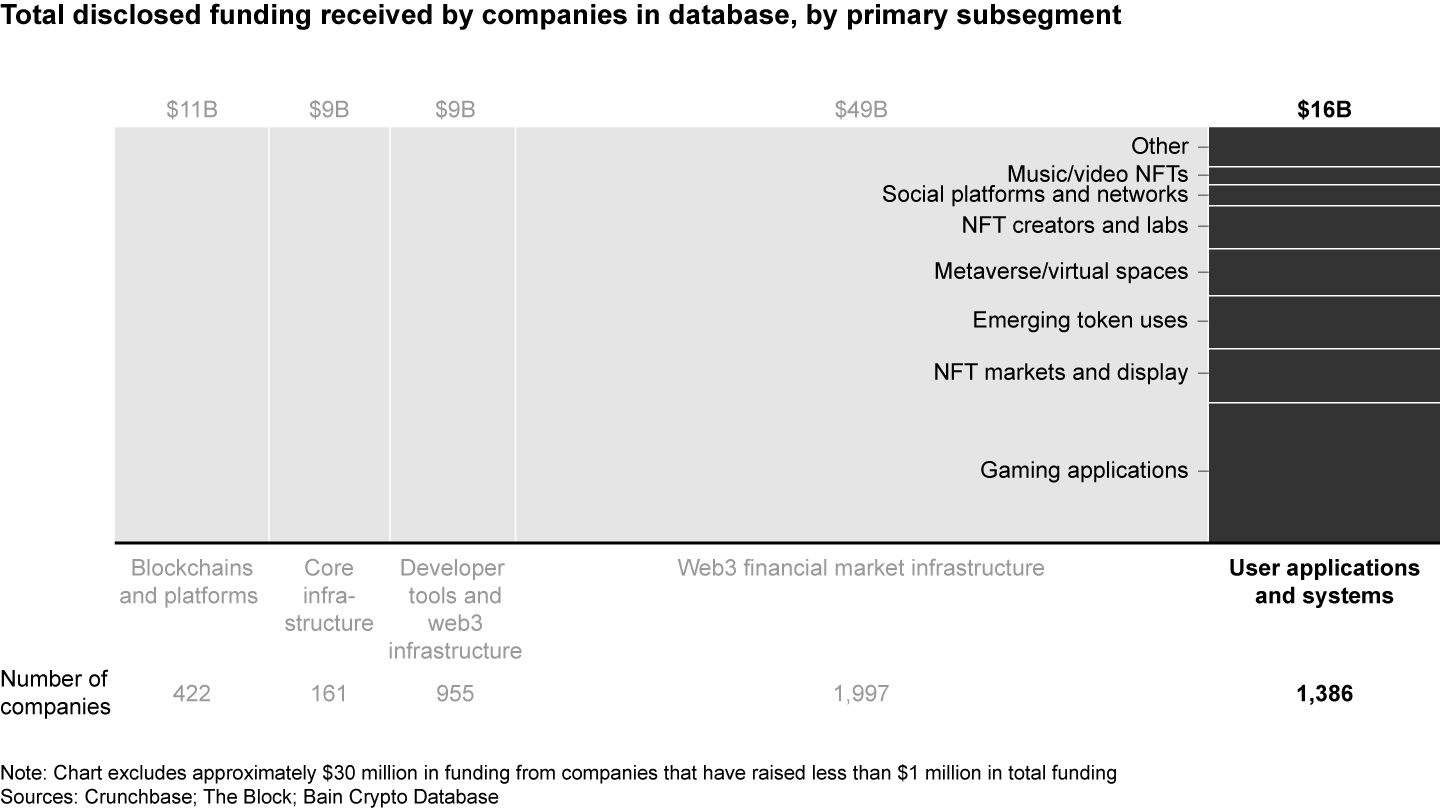
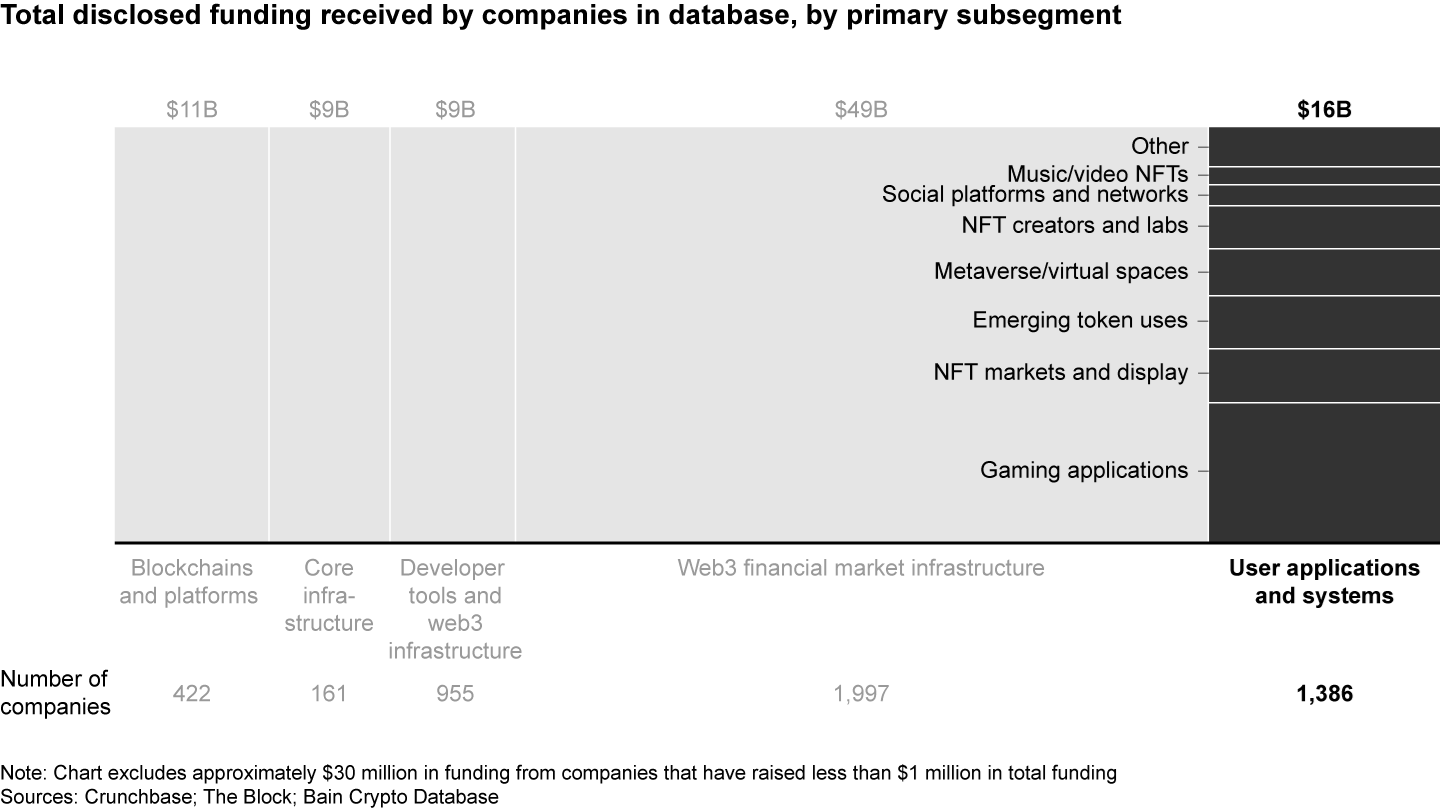
Clearly, the activity within these themes runs the gamut in terms of risk. The sector is rife with highly speculative, overly leveraged, or outright unsustainable business models, many of which are currently being shaken out. But there are also later-stage companies with more scale that have real structural value and staying power. Given the sector’s general state of fluidity, many investors may choose to focus on the closest thing this space offers to traditional tech-sector investing—“pick and shovel”-type companies that are both supporting current web3 activity and positioning themselves to take advantage of emerging use cases across the economy.
One example is Fireblocks, a promising custodial infrastructure platform that announced in September 2022 that its annual recurring revenue had surpassed $100 million. Fireblocks develops enterprise software tools that help companies manage digital asset operations. Financial companies like BNY Mellon use the software to securely hold clients’ digital assets in regulatorily compliant custody, and Fireblocks maintains a settlement network so those assets can be transferred seamlessly between Fireblocks wallets when they are bought and sold. The company has raised $1 billion in funding from BNY Mellon and other leading investors, including Coatue and General Atlantic, partly on the bet that crypto is just the beginning. Currently, Fireblocks solutions focus on safely storing and transferring tokens like Bitcoin, but the company is positioned to service firms storing other tokenized assets that might emerge in the future.
Other pick-and-shovel companies include “node” businesses like Alchemy and QuickNode, which help run the connection points between users or developers and chains, whether the transactions involve crypto, tokenized bonds, or anything else. Likewise, Chainalysis, Elliptic, and TRM use analytics in various forms to monitor transactions and smart contracts on blockchains to ensure compliance and that the digital infrastructure is safe. Crypto-related applications have powered growth for these companies so far, but their technology can monitor any kind of blockchain transaction. That helps explain why Mastercard bought Chainalysis competitor CipherTrace in 2021 to “differentiate its [Mastercard’s] card and real-time payments infrastructure” as merchants increasingly seek to build virtual asset offerings.
What’s become abundantly clear in the wake of the crypto collapse is that underwriting risk in this space requires a blend of web3 expertise and common business sense. Much as it was in the dot-com era, the investors that have run into trouble are those that failed to truly understand underlying business models—or if there even was one. Too many this time around have placed what amounted to heavily leveraged bets on companies whose value rested on the price of crypto, often perilously so.
What’s become abundantly clear in the wake of the crypto collapse is that underwriting risk in this space requires a blend of web3 expertise and common business sense.
As the dot-com bubble taught us, the biggest gains in the aftermath of a crash accrue to investors that can sift through the wreckage and identify the companies with viable, scalable business models—the best-in-class companies that are capable of generating cash sooner rather than later. Public markets will buy and sustain anything the venture funds are selling on the way up, but only some will find a way forward once the spigot is turned off.
Web3 is nascent enough that winners and losers are difficult to discern right now. But that’s why the funds with the best chance of identifying them are standing up web3 teams and marrying them with their firms’ seasoned investment professionals. Finding strong targets and underwriting risk will rely on the ability to draw out potential scenarios using a future-back approach. But it will also require fundamental due diligence. Is the business plan viable? What is the unit-cost analysis? When can investors reasonably expect to see real cash flow? Who are the company’s customers, and are they credible? Is there a path to scale?
Firms can tailor the decision to invest in the web3 space to match their mandate and risk appetite. But success will ultimately entail augmenting your differentiated value proposition with web3 knowledge and expertise. While that takes commitment, it will likely pay off in fresh investable insights as web3 continues to evolve.
Identifying disruption threat (and opportunity) across the portfolio
While funds that focus on more mature companies and industries may not want to play in the web3 arena, they’d be ill advised to ignore it. Over the next decade, the burgeoning set of web3 innovations could affect a broad sweep of industries and companies, some of which aren’t necessarily obvious today.
Funds need to understand what these changes might mean for more traditional portfolio companies—both in terms of disruption risk and opportunities to go on offense. Those insights come from scanning the current portfolio for potential web3 exposure and probing these issues in due diligence.
One large diversified fund, for instance, has evaluated where web3 developments could present threats or opportunities for portfolio companies and where the potential impact is too far off to worry about given the expected holding period. These insights flow to the firm’s portfolio teams, who can then use them to help companies navigate challenges or seize opportunities.
They also inform due diligence. When conducting diligence on a payments company recently, another large buyout fund added a web3 module to its usual process. That helped the team discover potential risks of web3-based disruption, which ultimately became meaningful in valuing the company.
The most effective scans map a portfolio sector by sector, looking at the pace of potential disruption, regulatory changes, and other factors that might accelerate or decelerate change. That leads to a clearer picture of how and when web3 is likely to reshape the industry and how much opportunity there might be to capitalize on those shifts (see Figure 4).
Figure 3: Figure 4
Web3 has the potential to reshape profit pools in several industries, particularly financial services, tech/telecom, and sports/entertainment
In sectors like financial services, the threat of significant change is already apparent. But the balance of risk and opportunity differs by subsector—and even for individual companies within a subsector. In payments, for instance, open transactional infrastructure and lower-cost networks could pose a threat to traditional interchange and other profit pools over the next 10 years. Yet there’s real potential for incumbents to adapt, using web3 technology to develop faster, lower-cost payment rails that can build on and improve existing industry infrastructure.
In other sectors, like sports, media, and entertainment, there is less potential for wholesale industry transformation but a rich opportunity to create new products, customer engagement models, or monetization strategies. A good example is Breitling, owned by Partners Group and CVC, which is using NFTs to give customers ready access to product and warranty information, as well as the ability to transfer ownership via blockchain. Practically every sports league globally is studying or experimenting with NFT ticketing and other ways to boost fan loyalty and monetize content. Ticketmaster now enables event organizers to link NFTs to an attendee’s ticket.
As these technologies find their way into more and more sectors, they have the potential to alter the competitive landscape and shift profit pools. That should make web3 top of mind for fund managers and portfolio companies.
A web3 lens on fund management
Even as they consider how web3 is affecting companies in their portfolios, a growing number of private equity firms are moving decisively to explore how web3 might change the way they think about strategy and operations. The ability to tokenize real assets via blockchains and smart contracts could lead to important innovations and features for alternative asset products.
Notably, tokenization could allow fund managers to build in tailored secondary liquidity mechanisms or make it easier to use fund investments as collateral. That offers a range of potential benefits:
- It could enhance fund-raising potential by opening up portfolios to a broader set of investors, including high-net-worth and affluent individuals, who hold a massive pool of capital largely untapped by private equity funds.
- It could create a differentiated value proposition by lowering upfront investment requirements and giving individual investors a streamlined experience, much like how they manage their investments in traditional public securities.
- On the operations side, tokens could lower administration costs by automating manual processes and enabling structured secondary trading mechanisms, custody, margin lending, reporting, and other features that could also be tailored to different types of fund products.
- Smart contracts and distributed ledgers promise to enhance efficiency and transparency by creating an immutable record of historical token ownership, lowering the cost and complexity of reporting and regulatory compliance.
For large firms looking to accelerate growth in assets under management (AUM), fund tokenization has become a significant focus. As we discuss elsewhere in this report, half of the world’s investable wealth is owned by individuals. Yet these investors account for only 16% of the AUM held by alternative funds. Tokenization is one way to tap this vast market.
Individual investors account for only
Already, many private equity players have launched pilots to explore how they can take advantage of the liquidity, efficiency, and distribution benefits of tokenized business models. As early as 2021, Apollo teamed up with infrastructure provider Figure to develop blockchain-based financial applications. More recently, KKR worked with infrastructure partner Securitize to tokenize a small slice of its $4 billion Health Care Strategic Growth Fund II on the Avalanche blockchain. Tokens will be tradable on a secondary market managed by Securitize after a one-year holding period.
Partners Group and Hamilton Lane, meanwhile, are separately working with Singapore-based private markets exchange ADDX to tokenize parts of their €5.5 billion Global Value SICAV and $1.85 billion Global Private Assets funds, respectively. Both are going after an even broader set of investors by reducing the minimum ticket size to $10,000.
Theoretically, any asset class can be tokenized, but some are better suited than others. Inefficient, illiquid markets with easy-to-authenticate assets, like private equity, private debt, and private real estate, probably have the most to gain. Compared with public markets, these three fund classes have relatively manual and costly processes. Yet they have massive pools of AUM that are currently off limits to most investors (see Figure 5). Tokenizing these markets could introduce a step change in efficiency and access.
Figure 3: Figure 5
Tokenization will most benefit private capital markets that are easy to authenticate but relatively inaccessible to many investors
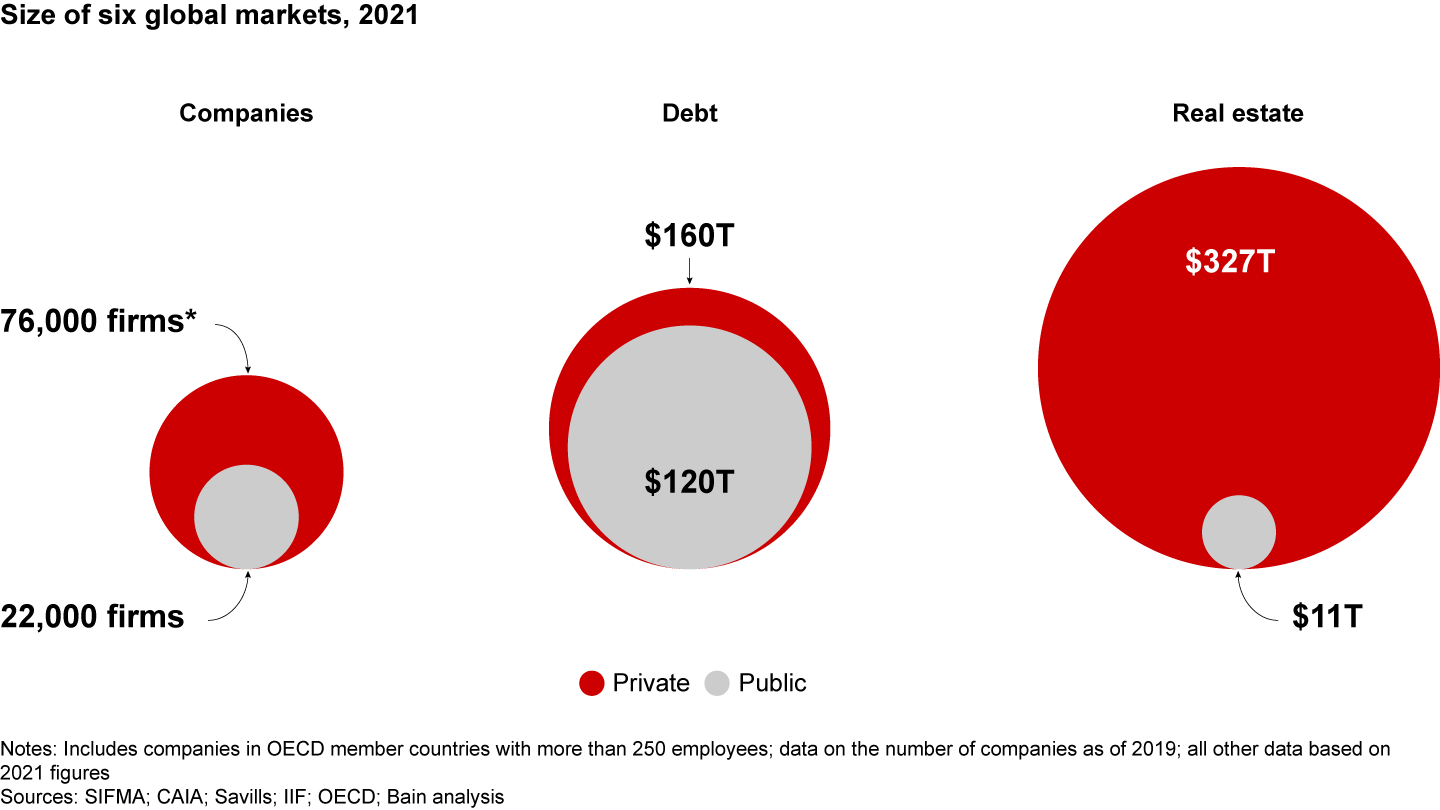
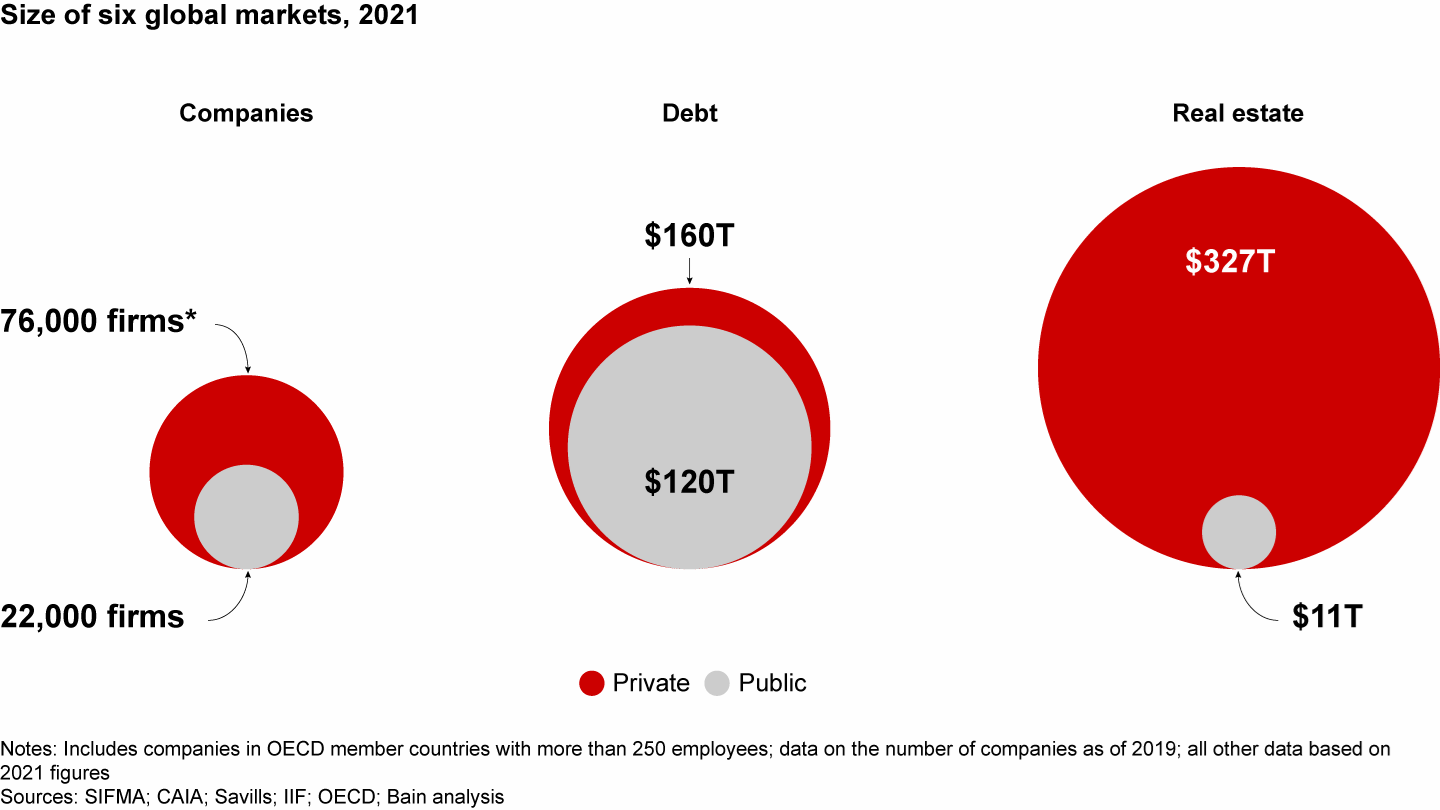
As a practical matter, few but the biggest funds have the resources to experiment with blockchain-based retail investor strategies today. Development costs are high, and there are many challenges to broader implementation. One of the trickiest issues is how to manage investor expectations around liquidity provisions involving relatively illiquid assets. Blackstone found that out last year when its retail-focused real estate and credit funds were hit with a wave of redemptions that forced some rethinking on liquidity policies and tools.
Nearer at hand, however, are solutions based on blockchains and smart contracts that can transform back-office operations. It’s easy to imagine a time in the not-so-distant future when the back-office staff devoted to all the nuts and bolts of fund administration shrinks, even as the fund manages a more complex group of products and limited partners (LPs). Smart contracts can readily automate routine tasks like distributions or capital calls. They can maintain cap tables or ensure that tax issues are handled promptly and efficiently, including for LP holdings that have been transferred in a secondary transaction. With fund details and investment transactions recorded on the blockchain, funds will be able to provide new visibility to regulators and speed up the compliance process. These innovations can streamline interactions with LPs and other investors while cutting costs and freeing up dollars to be put toward investment activity.
Standing up these solutions will require investment, but probably not as much as one might expect. Already, companies like FIS, Broadridge, and iCapital are building blockchain-based administration solutions aimed at middle-market funds. The message is clear: Funds don’t need to develop their own web3 solutions. For most, the right approach may be to work with the innovative fund administrators and technology providers capable of developing tools and solutions for them.
Whether you’re an investor funding the next generation of IT infrastructure, a fund manager performing due diligence on traditional companies exposed to web3 changes, or a PE strategist evaluating new types of funds and distribution channels, web3 is very likely to emerge as a critical theme over the next 10 years. It may not be time yet to dive in headfirst. But, for many funds, it is time to begin building depth in web3 and evaluating how to turn this technological shift into an advantage.